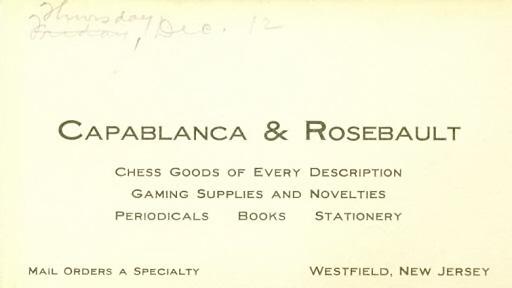
Edward Winter
From Dale Brandreth (Yorklyn, DE, USA):
‘One interesting sidelight on Capa is what happened to Rosebault, his business manager. After about 1912 he seems to have disappeared from the scene and I have never found any trace of him thereafter in chess literature. Norman T. Whitaker told me – a dozen or so years ago – that he and Capa used to “double-date”, i.e. N.T.W. and Capa would take out a pair of ladies for the evening. During one of their social occasions he was told by Capa that he had dropped Rosebault as his manager because Rosebault was a homosexual. This is, of course, hearsay, but I tend to believe that Capa told Whitaker that. There is no reason for Whitaker to have made it up since there was no gain to him to disparage a rather obscure figure such as Rosebault. Undoubtedly Rosebault would have known a great deal about the young Capa, and even though he could scarcely be alive today, it is not inconceivable that he has descendants who might have some effects or stories of interest. It would seem most likely that he stayed in New York, but that he left the chess world.’
(1307)
Since nobody has yet replied to C.N. 1307, we have put together some notes on Rosebault.
As a player he was quite active in New York for a short period. He participated in the New York State Tournament of 1910, his loss to Capablanca being one of the few games missing from the Wildhagen volume on the Cuban. The 1912 American Chess Bulletin (page 147) reports that he took part in an impromptu rapid transit tournament at the Manhattan Chess Club, finishing third with two and a half points out of five, behind Capablanca (first with a perfect score) and Albert Pulvermacher (second with four points).
He regularly took a board for the Manhattan Chess Club and in 1909-10 participated in the Club’s Championship Tournament, playing the following game (given on page 120 of the 8 January 1910 issue of the Chess Weekly):
J.M. Hanham – F.D. Rosebault
New York, 1909
King’s Pawn Opening
1 e4 e5 2 d3 d6 3 c3 c6 4 Nf3 Nf6 5 Nbd2 Nbd7 6 Be2 Be7 7 O-O O-O 8 Re1 Re8 9 Nf1 Nf8 10 Ng3 Ng6 11 Bf1 Bf8 12 h3 h6 13 Qc2 Qc7 14 Be3 Be6 15 d4 d5 16 dxe5 Nxe4 (Breaking the – record length? – symmetry) 17 Nxe4 dxe4 18 Qxe4 Bd5 19 Qf5 Nxe5 20 Nd2 Ng6 21 Bd3 Re5 22 Qg4 Be6 23 Qa4 Ra5 24 Qc2 Nf4 25 Bf1 Rh5 26 Qe4 Rh4 27 Qf3 Bd5 28 Qg3 Nxh3+ 29 gxh3 Bd6 30 f4 Rxf4 31 Bxf4 Bxf4 32 Qf2 Bg3 33 Qe2 Bxe1 34 Rxe1 Qg3+ 35 Bg2 Bxg2 36 Qf2 Qxf2+ and wins.
When Emanuel Lasker gave a simultaneous exhibition at the Manhattan Chess Club on 14 October 1911, scoring +23 –0 =1, it was Rosebault who took the draw, an interesting battle lasting 55 moves (to be found on page 71 of Emanuel Lasker Volume 3 edited by Ken Whyld).
Rosebault was Capablanca’s representative in the world championship match negotiations with Lasker (see page 4 of issue 1 of Lasker & His Contemporaries, a well documented article by Bob Dudley):
‘On 4 November 1911 Dr Lasker delivered a lecture on the “Significance of Chess” at the Brooklyn Institute of Arts and Sciences. Following the talk, the large crowd repaired to the art room where Dr and Mrs Lasker held an informal reception. During a break in the conversation a tall, young man stepped up to Lasker and exchanged a few words with him. He was F.D. Rosebault, representative of Capablanca, and he had unostentatiously handed Lasker a written challenge received in the morning’s mail ...’
The negotiations dragged on, but came to nothing.
Rosebault was occasionally mentioned in Capablanca-Magazine, mainly in his capacity as manager of the planned New York/Havana tournament, eventually abandoned in or around November 1912. He was normally referred to as ‘F.D. Rosebault’ (forenames never given). The inside front cover of the magazine regularly had a half-page advertisement for ‘Capablanca and Rosebault, Importers and Exporters, P.O. Box 1013, New York, Cable: CAPA, New York’. The company sold chess literature and equipment of all kinds, welcoming ‘individual or bulk orders’.
But the 15 December 1912 issue of Capablanca-Magazine (page 239) reported:
‘The business relations between Señor José Raúl Capablanca and Mr F.R. [sic] Rosebault have been broken off. The Capablanca and Rosebault company, which had been our magazine’s exclusive agent in the United States, has consequently been dissolved. Subscribers in the United States will be receiving the magazine direct from us until a new agent is appointed.’
It may be significant that on 3 September Capablanca had resigned from the Manhattan Chess Club with immediate effect. The 1912 American Chess Bulletin, page 252, reported that ‘the trouble which had been brewing for several days between Jose R. Capablanca and the directors of the club, in consequence of the readmission of a certain former member, had got beyond the point where it could be effectually patched up’. We would welcome more information.
Shortly before their break-up, Rosebault and Capablanca had been planning a new magazine, in English, called the Chess Forum. In La Discusión of 22 September 1912 Capablanca announced that the first issue was due to appear the following month, saying that details about the new magazine could be obtained from an office at 34 Park Road, New York City. (Can an American reader investigate whether this address gives any clues about Rosebault?) The imminent publication was also mentioned on page 160 of the 15 September 1912 issue of Capablanca-Magazine, although the report there that the Chess Forum was to appear in London was presumably an error for New York – Capablanca did not visit Europe in 1912.
Page 22 of the 1913 BCM gave the reaction of Felix E. Kahn (the treasurer of the ill-fated New York/Havana tournament) to a circular sent out on 10 December 1912:
‘He also declared that the use of his name on a recent circular announcing the appearance of the Chess Forum, issued by F.D. Rosebault, managing director of the international tournament, who expected to publish it with J.R. Capablanca as editor-in-chief, had been entirely unauthorized. While Mr Kahn, in the interest of chess, aided them financially, he did not enter into partnership or make any publishing contract with them whatsoever.’
So in the last quarter of 1912 there could well have been professional tension between Rosebault and Capablanca. The world title challenge, the New York/Havana tournament and the new magazine the Chess Forum had all failed to materialize. Could that be why the Capablanca-Rosebault partnership foundered?
(1341)
C.N. 1423 gave a correction to C.N. 1341: the newspaper of 22 September 1912 which announced the imminent publication of The Chess Forum was Diario de la Marina, and not La Discusión.
Frederick D. Rosebault was briefly Capablanca’s business associate and was involved in the Cuban’s failed attempts to secure a world championship match against Lasker in 1911-12. (See page 358 of A Chess Omnibus – C.N. 2495 – and various references to Rosebault in our book on Capablanca.) In late 1912 the Capablanca-Rosebault partnership sustained a series of setbacks: the aborted world title negotiations, the failure of the planned New York/Havana tournament and the non-appearance of a projected magazine, the Chess Forum, but it is not known for certain why Capablanca broke off his relations with Rosebault that December.
Below, from our collection, is the Capablanca-Rosebault business card:

In 1987 we tried to find out more about Rosebault, having noted references to him in chess literature as ‘F.D. Rosebault of Westfield, NJ’. As reported in C.N. 1431, the Westfield Memorial Library informed us that the 1900 archives contained nothing on anybody named Rosebault. However, later city directories gave:
There was no subsequent listing in the directories.
The 1900 census provided some additional information on the Rosebault family:
New York, King’s County, Brooklyn, 359 Jefferson Avenue:
The 1910 census gave the same data, except that the place of residence was Westfield.
C.N. 1461 added that the death of Leonard W. Rosebault, in Cranford, NJ, was reported on page 31 of the New York Times, 19 August 1965. It may be noted now that the US Social Security Death Index (as made available at www.familysearch.org) has his date of birth as 24 March 1886.
The earliest reference we have noted in chess literature to any Rosebault is on page 261 of the July 1905 American Chess Bulletin, which reported on a nine-board match ‘for the interborough scholastic championship of Greater New York’ (Manhattan v Brooklyn). On board three a player named Rosebault (no initial given) from Euclid School scored a draw for Brooklyn.
A key unresolved question has been when F.D. Rosebault died, but while preparing this item we came across the following webpage: http://www.interment.net/data/us/ca/losangeles/lanat/r/lanat_r10.htm.
This lists the death of a Frederick D. Rosebault on 16 December 1945, recording that he had been a Private in Company G of the 51st Infantry Regiment, 6th Division. It is unfortunate that no year of birth was stipulated, to settle beyond reasonable doubt whether he was indeed Capablanca’s mysterious business partner.
(3559)
Walter B. Hart (Burra Creek, Australia) asks whether the moves of Rosebault’s game against Capablanca in the New York State Tournament on 22 February 1910, one of the very few scores absent from the 1963 Wildhagen volume on the Cuban by J. Gilchrist and D. Hooper, have ever been found.
We believe not. Our correspondent points out that an article by V. Fiala on page 19 of the 4/2000 Quarterly for Chess History stated that Capablanca’s victory was in 40 moves, and we have no information beyond that.
(3568)
Below is ‘a lively little game’ at the Manhattan Chess Club which Rosebault lost to an opponent who was playing blindfold:
Paul F. Johner – Frederick D. Rosebault1 d4 d5 2 Nf3 e6 3 Bf4 Nf6 4 e3 c5 5 c4 Nc6 6 Bd3 Bd6 7 Bg5 Be7 8 Nc3 O-O 9 O-O a6 10 Ne5 dxc4 11 Nxc6 bxc6 12 Bxc4 cxd4 13 exd4 c5 14 Qf3 Rb8 15 dxc5 Bxc5 16 Rad1 Qe7 17 Rfe1 Rxb2 18 Nd5 Qa7 19 Nxf6+ Kh8 20 Qh5 h6 21 Bxh6 g6 22 Qe5 Rxf2 23 Kh1 Bb7 24 Bg7+ Kxg7 25 Ne8+ Kh6 26 Qg7+ Kg5 27 h4+ Kg4 28 Nf6+ Kf5

29 Re5+ ‘and mate in three’.
Source: Chess Weekly, 29 January 1910, page 142.
(3669)
Russell Miller (Chelan, WA, USA) adds some intriguing complications to C.N. 3559 above. As regards, firstly, the military record, he notes that the website www.ancestry.com has, under ‘Ohio Military Men 1917-1918’, the following entry:
‘Frederick D. Rosebault
Residence: Canton, O.
Enlisted at Fort Thomas, Ky on 13 May 1918
Born Brooklyn, New York on 27 July 1888
Co G 51 Infantry to Discharge Private Honorable discharge 18 July 1919
Surgeon’s Certificate of Disability 15% disabled.’
Moreover, there is a World War I Draft Registration Card dated 8 June 1917 (Canton, OH) for Frederick Dana Rosebault, whose home address was given as YMCA, Canton, OH. It was furthermore stated that he was born in Brooklyn, NY on 27 July 1888, and the following particulars were added: ‘Special Officer for Canton Steel Foundry Co., no children, single, tall, blue eyes, brown hair, not bald, not disabled.’ The signature on the card was: Frederick D. Rosebault.
Next, our correspondent points out that the 1920 Federal Census listed, at 42 State St., East Orange, Essex Co., NJ, Walter Rosebault, his wife Sarah W. and their sons Frederick D. (aged 31, no occupation stipulated) and Alfred P. (occupation ‘US Army, Now in Europe’).
Finally, Mr Miller refers to the California Death Index at http://www.ancestry.com/search/db.aspx?dbid=5180. This lists a Sarah Parker, who was married to a man named Rosebault (forename not given), and a Frederick Danar Welles, who was born on 27 July 1888 in New York and died on 16 December 1945 in Los Angeles. Our correspondent suggests that Rosebault may have changed his name to Welles.
The evidence currently available does indeed strongly suggest that Frederick D. Rosebault, Frederick Dana Rosebault and Frederick Danar Welles were the same person. The one inconsistency in the birth-date is that the 1900 and 1910 censuses gave July 1887, whereas the other sources referred to above had (27) July 1888. (The year 1888 is also consistent with the above-mentioned reference to ‘aged 31’ for Frederick D. Rosebault in the 1920 census.) Both Frederick Dana Rosebault and Frederick Danar Welles are listed as having been born in New York on 27 July 1888 but, if they are indeed the same person, when and why did Rosebault change his surname to Welles? (The 1920 census listed his mother as ‘Sarah W.’ Did the W. perhaps stand for Welles?)
In fact, though, we can demonstrate a link between the names Rosebault and Welles. At the time Capablanca and Rosebault were in partnership, a brochure was issued by ‘Capablanca & Rosebault Chess Supplies and Literature, P.O. Box 1013, New York’. Just a few pages long, it was entitled A Brief Review of the Chess Record of José Raúl Capablanca, with the sub-heading ‘and the official announcement of his fourth American tour 1911-1912’. The author was named as Dana Welles.
Our copy of this extremely rare publication has seen better times, as may be noted from the reproduction below of the front cover:
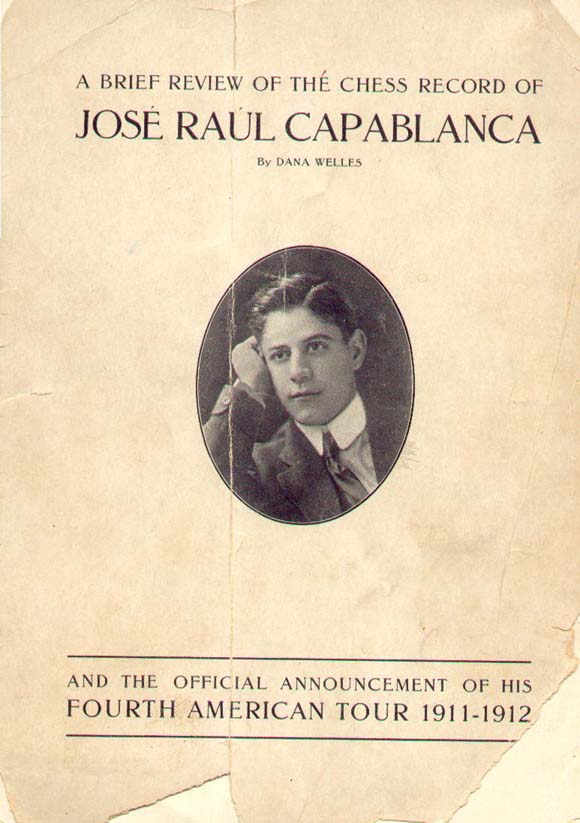
To summarize, the evidence currently available suggests that some time after the 1920 census Frederick Dana Rosebault changed his name to Frederick Dana Welles, having already used ‘Dana Welles’ as a pseudonym for the chess brochure which he issued jointly with Capablanca in 1911.
(3674)
Russell Miller (Chelan, WA, USA) provides a family link between Frederick D. Rosebault and the name Welles. His mother’s maiden name was Sarah W. Parker, and from the webpage http://wc.rootsweb.com/cgi-bin/igm.cgi Mr Miller has determined that her mother was Sarah Welles, born in New York circa 1824.
(3685)
Tom Rogers (Westfield, NJ, USA) has joined in the hunt for information about Rosebault and provides the photograph below of 514 Kimball Avenue, Westfield as it stands today. C.N. 3559 mentioned that Rosebault lived with his family at that address circa 1911.
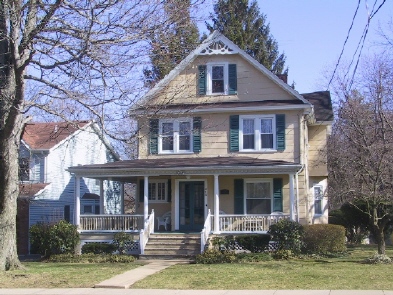
(4241)
Addition on 9 January 2011:
Olimpiu G. Urcan (Singapore) has sent us the following cuttings:

Brooklyn Daily Eagle, 19 January 1909, page 3

Brooklyn Daily Eagle, 21 January 1909, page 4

Brooklyn Daily Eagle, 27 January 1909, page 16
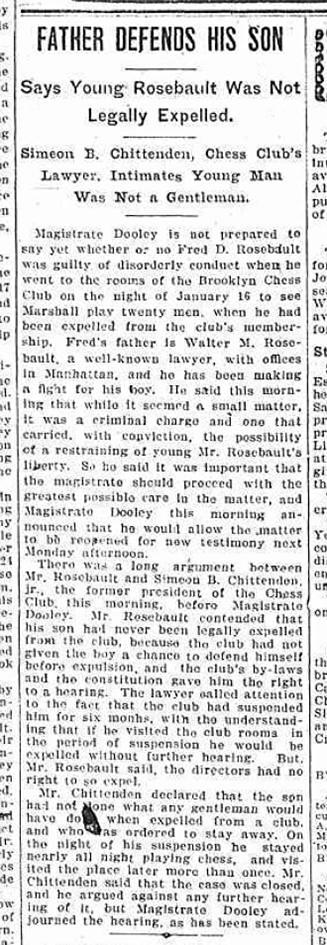
Brooklyn Daily Eagle, 3 February 1909, page 3
A report on the outcome of the case has yet to be found.
A game from Eduardo Bauzá Mercére (New York, NY, USA):
Magnus Smith (blindfold) – Frederick D. Rosebault
Brooklyn, 1907
(Remove White’s king’s knight.)
1 e4 e5 2 Bc4 Nf6 3 Nc3 Bb4 4 O-O Bxc3 5 dxc3 d6 6 Bg5 h6 7 Bh4 Be6 8 Bd3 d5 9 exd5 Bxd5 10 Qe2 Nbd7 11 Rad1 Qe7 12 c4 Bc6 13 c3 O-O-O 14 b4 a6 15 a4 Bxa4 16 Ra1 Bc6 17 b5 Nc5 18 bxc6 Rxd3 19 cxb7+ Kxb7 20 Rfb1+ Ka7
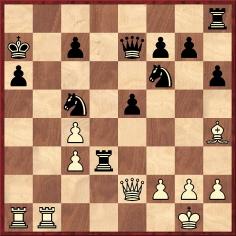
21 f3 Rb8 22 Bf2 Rdd8, and White mates in three (23 Rxa6+ Kxa6 24 Qa2+ Na4 25 Qxa4).
Source: Winnipeg Free Press, 23 November 1907, page 27:
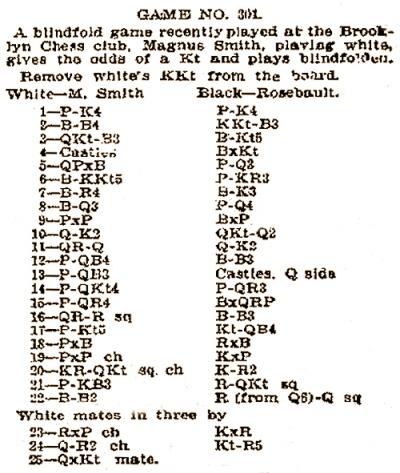
(8491)
Rosebault featured prominently in the satirical essay Polnische Wirtschaft in Amerika by Tarrasch towards the end of his book Die moderne Schachpartie (page numbers vary, depending on the edition).
In 1987 we gave the following brief item (C.N. 1520):
Page 190 of the December 1920 American Chess Bulletin reported on the festivities held at the New York home of the violinist Mischa Elman on 7 December 1920. The guests, who presented Reshevsky with a diamond ring (the ideal gift for a nine-year-old ...), included ‘Mr and Mrs Rosebault’.
Was this F.D. Rosebault? If so, it is the first post-1912/13 reference to him that we have found.
Russell Miller notes that according to the World War I Draft Registration Cards, 1917-1918 the second forename of Leonard Rosebault was Welles.
An early mention of F.D. Rosebault, as a winner in a solving competition, was on page 150 of the Chess Weekly, 10 October 1908.
In October 1986, Dale Brandreth (Yorklyn, DE, USA) sent us a copy of this score-sheet of an undated Rosenthal v Rosebault game:
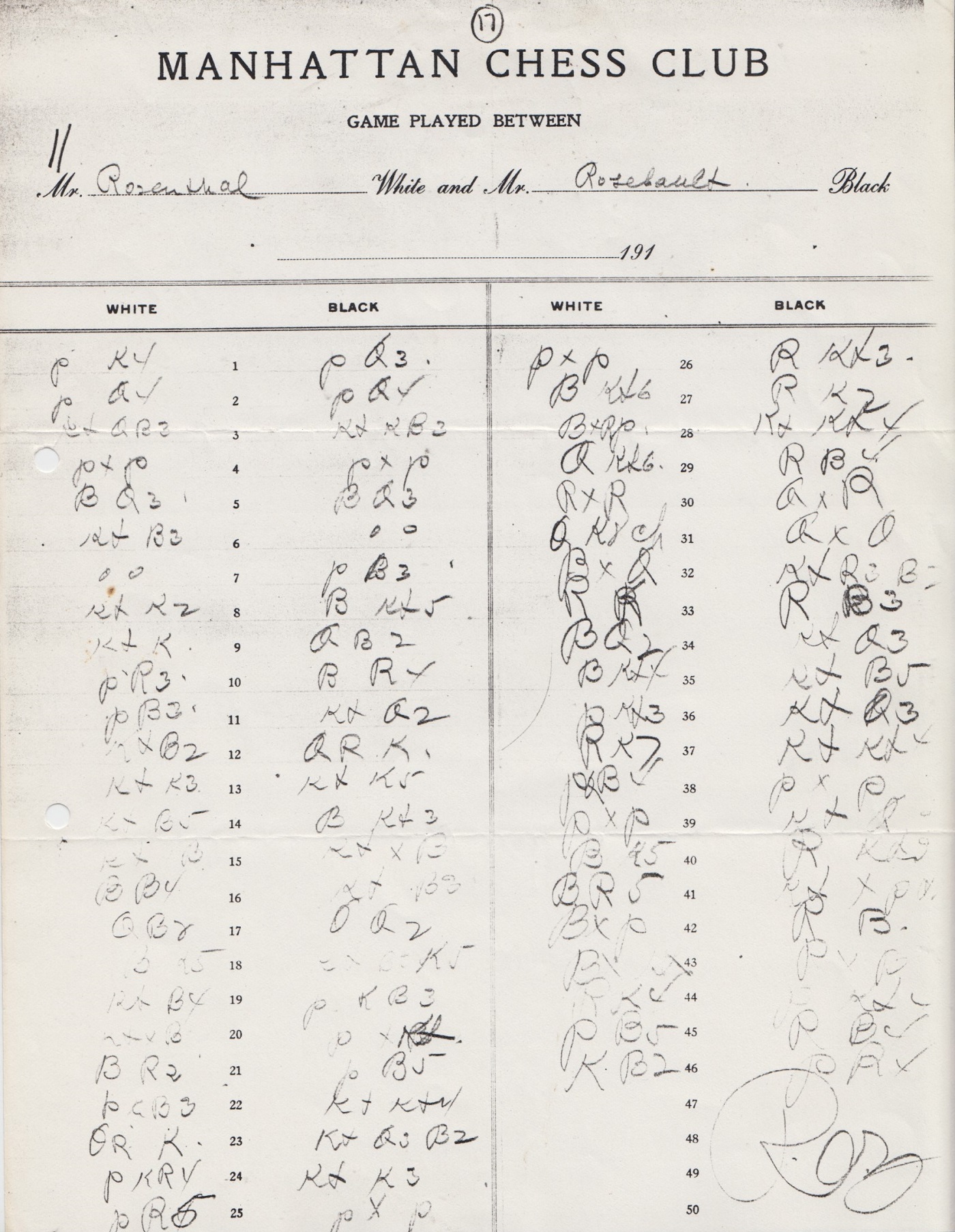
The following transcription has been provided by Olimpiu G. Urcan:
1 e4 e6 2 d4 d5 3 Nc3 Nf6 4 exd5 exd5 5 Bd3 Bd6 6 Nf3 O-O 7 O-O c6 8 Ne2 Bg4 9 Ne1 Qc7 10 h3 Bh5 11 c3 Nbd7 12 Nc2 Rae8 13 Ne3 Ne4 14 Nf5 Bg6 15 Nxd6 Nxd6 16 Bf4 Nf6 17 Qc2 Qd7 18 Be5 Nfe4 19 Nf4 f6 20 Nxg6 hxg6 21 Bh2 f5 22 f3 Ng5 23 Rae1 Ndf7 24 h4 Ne6 25 h5 gxh5 26 Bxf5 Nh6 27 Bg6 Re7 28 Bxh5 Ng5 29 Qg6 Rf5 30 Rxe7 Qxe7 31 Qe8+ Qxe8 32 Bxe8 Nhf7 33 Re1 Rf6 34 Bd7 Nd6 35 Bg4 Nc4 36 b3 Nd6 37 Re7 Nb5 38 c4 dxc4 39 bxc4 Nd6 40 Be5 Rg6 41 Bh5 Nxf3+ 42 Bxf3 Kf8 43 Bxd6 Rxd6 44 Re4 b5 45 c5 Rf6 46 Kf2 a5, and Black resigns.
Addition on 27 August 2022:
John Townsend (Wokingham, England) writes:
‘East Orange was also the residence mentioned in an entry for “Frederick Dana Rosebault” on page 261 of the National Year Book (1919) of the Society of the Sons of the American Revolution, where he is listed among the new members. The name Welles came from his mother’s side of the family, as the entry describes him, inter alia, as “Son of Walter M. and Sarah Welles (Parker) Rosebault; grandson of Ferdinand Fitzroy and Sarah (Welles) Parker ...”
When the New York Tribune announced the break-up between Rosebault and Capablanca on 21 November 1912 (page 10), it made it sound as if the failure of the New York-Havana tournament was the main factor. Janowsky, it said, had reported that Hoffer, the referee, had notified him that the tournament had been abandoned. This was Capablanca’s reaction:
“José R. Capablanca, the Cuban champion, who went to Havana some time ago in the interest of the tournament, was seen yesterday. He was reticent. ‘For the moment, I have nothing to say’, was all that could be obtained from him in the way of a statement.
Subsequently, Capablanca stated that he had severed all business relations with F.D. Rosebault, the managing director of the tournament. This was confirmed by Mr Rosebault.”’
To the Chess Notes main page.
To the Archives for other feature articles.
Copyright: Edward Winter. All rights reserved.